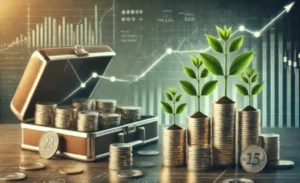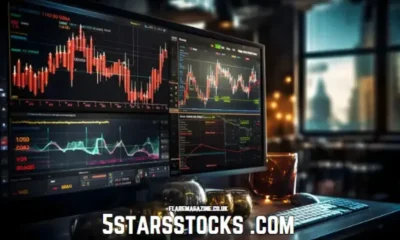Crypto Currency
5StarsStocks.com Nickel: A Guide to Smart Investments

In the dynamic landscape of commodities, nickel has emerged as one of the most valuable assets for savvy investors. Its versatile applications, growing demand, and strategic importance in industries ranging from electric vehicles (EVs) to renewable energy storage make it a highly attractive prospect for individuals looking to diversify their portfolios. This guide, powered by insights from 5StarsStocks.com, delves into the fundamentals of nickel investments, providing actionable strategies and exploring its long-term potential.
Understanding Nickel’s Strategic Importance
Nickel is a critical industrial metal known for its corrosion resistance, high melting point, and remarkable strength. These qualities make it indispensable in producing stainless steel, which accounts for nearly 70% of global nickel consumption. However, the growing adoption of electric vehicles and renewable energy technologies has significantly expanded its utility. Nickel is a crucial component in lithium-ion batteries, particularly in cathode materials, due to its ability to enhance energy density and extend battery life.
This dual role of nickel—as both a traditional and modern industrial metal—positions it uniquely in global markets. Countries worldwide are ramping up their demand for nickel to meet sustainable development goals, particularly with government incentives promoting EV adoption and clean energy transitions. For investors, this translates to a commodity with both steady industrial demand and exponential growth potential.

Key Drivers of Nickel Demand
Several macroeconomic and industrial factors contribute to the rising demand for nickel. Chief among these are:
- Electric Vehicle Boom
As automakers transition from fossil fuel-powered vehicles to EVs, nickel-rich batteries like Nickel-Cobalt-Aluminum (NCA) and Nickel-Manganese-Cobalt (NMC) chemistries are becoming industry standards. The rise in EV adoption directly correlates with the demand for nickel, which forms an integral part of these batteries. For instance, Tesla and other leading automakers have increasingly highlighted the importance of securing nickel supplies to meet their production goals. - Urbanization and Infrastructure Growth
Rapid urbanization in emerging economies such as India, China, and Southeast Asia has driven the demand for stainless steel, further bolstering nickel consumption. Infrastructure projects, including bridges, railways, and high-rise buildings, extensively use stainless steel due to its durability and strength. - Green Energy Revolution
Beyond EVs, nickel’s role in renewable energy storage systems is pivotal. Large-scale energy storage solutions, which are essential for integrating solar and wind power into national grids, rely on nickel-based batteries for efficient operation. This trend underscores the metal’s importance in global sustainability efforts.
Investing in Nickel: Opportunities and Risks
Nickel investments offer lucrative opportunities, but they are not without risks. Understanding the balance between these aspects is crucial for any investor.
Opportunities
- Market Growth Potential: The global nickel market is expected to grow substantially, with forecasts indicating a steady rise in demand and price appreciation. According to industry reports, the nickel market could witness a compound annual growth rate (CAGR) of 5-8% over the next decade.
- Diverse Investment Vehicles: Investors can access nickel through multiple avenues, including direct commodity trading, mining stocks, exchange-traded funds (ETFs), and futures contracts. Each approach offers unique benefits tailored to different risk appetites and investment strategies.
- Government Incentives: Policies promoting EV production and renewable energy adoption indirectly boost nickel demand. Investing in this commodity aligns with long-term trends supported by global initiatives.
Risks
- Market Volatility: Like most commodities, nickel prices are susceptible to fluctuations driven by geopolitical tensions, supply chain disruptions, and macroeconomic factors.
- Environmental Concerns: Mining and refining nickel pose environmental challenges, potentially leading to regulatory crackdowns or operational halts for mining companies. Investors must remain vigilant about these risks when choosing stocks or ETFs.
- Technological Substitutions: Advances in battery technology could reduce nickel usage, though such developments remain speculative at this stage.
How to Invest in Nickel: A Step-by-Step Approach
Investing in nickel requires careful planning and execution. Here’s a step-by-step guide to help investors make informed decisions:
1. Choose Your Investment Vehicle
- Direct Commodity Investments: Buy physical nickel or invest in commodity futures if you have expertise in market trading.
- Nickel Mining Stocks: Invest in companies involved in nickel mining and refining. Examples include Norilsk Nickel, Vale S.A., and BHP.
- Nickel ETFs: Exchange-traded funds like the Global X Nickel Miners ETF offer diversified exposure to nickel-focused companies.
2. Analyze Market Trends
Monitor key indicators such as global nickel production, inventory levels, and consumption patterns across industries. Staying informed will help you identify the right entry and exit points.
3. Assess Environmental and Social Factors
Sustainability is becoming a decisive factor in investment decisions. Prioritize companies that adhere to environmentally friendly mining practices and ethical labor standards.
4. Diversify Your Portfolio
Avoid overexposure to a single commodity or asset. Diversify your investments across sectors to minimize risks and optimize returns.
Spotlight: Major Players in the Nickel Industry
Several companies dominate the global nickel market, offering unique investment opportunities. Below is a list of key players and their significance:
- Norilsk Nickel (Russia): One of the largest nickel producers, Norilsk plays a crucial role in global supply. The company’s vertically integrated operations provide stable production capabilities.
- Vale S.A. (Brazil): A major mining conglomerate, Vale is renowned for its large-scale nickel production and innovative extraction technologies.
- BHP (Australia): Known for its diversified portfolio, BHP is heavily invested in nickel, with significant operations in Australia and Indonesia.
- Eramet (France): This mining and metallurgy group specializes in high-grade nickel production, focusing on sustainable practices.
Benefits of Nickel Investments
- Steady Demand Across Sectors: From stainless steel to electric vehicles, nickel has versatile applications, ensuring consistent demand.
- Growth Aligned with Sustainability Goals: Investing in nickel supports global transitions to clean energy and electric mobility.
- Hedge Against Inflation: Commodities like nickel often act as a hedge against currency devaluation and inflation.
- Portfolio Diversification: Adding nickel investments to your portfolio enhances diversity, reducing overall risk exposure.

Emerging Trends in the Nickel Market
Several emerging trends are shaping the future of nickel investments:
- Recycling and Circular Economy Initiatives
The nickel recycling market is gaining traction as industries seek to minimize environmental impact. Recycling nickel from batteries and industrial waste offers a sustainable approach to meeting demand without expanding mining operations. - Technological Advancements in Extraction
Innovations like high-pressure acid leaching (HPAL) are improving the efficiency of nickel extraction, particularly from laterite ores. These advancements could lower production costs and make the market more accessible. - Geopolitical Dynamics
Countries with significant nickel reserves, such as Indonesia and the Philippines, are leveraging their resources to gain geopolitical clout. Policies around export restrictions and local value addition can impact global supply dynamics.
Conclusion
Nickel stands at the intersection of traditional industrial applications and cutting-edge technologies. Its dual role as a staple for stainless steel production and a critical component in EV batteries makes it a robust investment choice. The insights provided by 5StarsStocks.com highlight nickel’s growing prominence and underline its potential as a long-term investment.
By understanding the fundamentals, leveraging market trends, and adopting a diversified approach, investors can unlock significant opportunities in the nickel market. As the world transitions to a greener future, nickel will undoubtedly remain a cornerstone of innovation and industrial progress.
FAQs:
1. What makes nickel a smart investment?
Nickel is a highly versatile metal with applications in both traditional industries (like stainless steel production) and modern technologies (such as EV batteries and renewable energy storage). Its growing demand, coupled with limited global supply, creates opportunities for significant price appreciation.
2. What are some alternatives to nickel for diversification?
Other commodities such as lithium, cobalt, and copper are complementary to nickel, particularly for investors interested in battery technology and renewable energy. Precious metals like gold and silver also serve as valuable diversification options.
3. Can nickel recycling affect its market dynamics?
Yes, nickel recycling is becoming a significant trend. It helps meet growing demand sustainably while reducing dependence on mining. However, recycled nickel alone may not satisfy the surging global requirements, keeping primary production essential.
-

 Blog8 months ago
Blog8 months agoDiscover The World Of Movies With Mkvcinemas.com
-

 Biography9 months ago
Biography9 months agoMadeline Argy: Age, Height, and Family Background Revealed
-

 Tech9 months ago
Tech9 months agoSimpCityForum: One of the Most Interesting Online Communities
-

 Biography9 months ago
Biography9 months agoCelebrityMeet Christina Erika Carandini Lee?: All You Need To Know
-

 Biography8 months ago
Biography8 months agoMary Marquardt: The Woman Behind Harrison Ford’s Rise
-

 Biography9 months ago
Biography9 months agoHow Old Is SZA Daughter? Discover SZA Daughter’s Age, Name, and More
-

 Crypto Currency9 months ago
Crypto Currency9 months ago5starsstocks .com: How It’s Useful and Helpful
-

 Blog9 months ago
Blog9 months agoWhat is FilthyGrid? Exploring the World of FilthyGrid
-

 Health & Fitness9 months ago
Health & Fitness9 months agoWhat Has Kiolopobgofit in It? Exploring the Enigmatic Concept
-

 Biography9 months ago
Biography9 months agoChevy Chase Net Worth, Bio, Age, Height, Wife & Family

